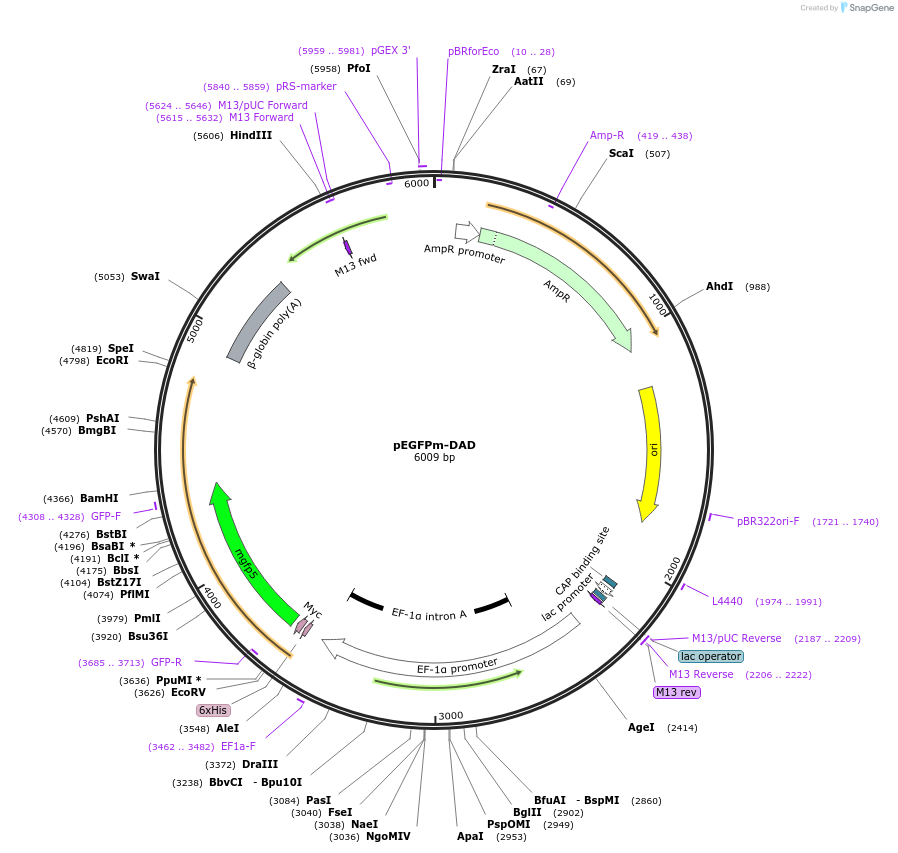pEGFPm-DAD
(Plasmid
#25410)
-
Depositing Lab
-
Publication
-
Sequence Information
Ordering
| Item | Catalog # | Description | Quantity | Price (USD) | |
|---|---|---|---|---|---|
| Plasmid | 25410 | Standard format: Plasmid sent in bacteria as agar stab | 1 | $89 | |
Backbone
-
Vector backboneEF-BOS
- Backbone size w/o insert (bp) 3000
-
Vector typeMammalian Expression
Growth in Bacteria
-
Bacterial Resistance(s)Ampicillin, 100 μg/mL
-
Growth Temperature37°C
-
Growth Strain(s)DH5alpha
-
Copy numberUnknown
Gene/Insert
-
Gene/Insert nameDiap3
-
Alt nameDiap3 Diaphanous-autoregulatory domain
-
Alt namemDia2 DAD
-
Alt nameDiap3 DAD
-
SpeciesM. musculus (mouse)
-
Insert Size (bp)433
-
MutationmDia2 Amino Acids 1031-1171; Q1091P mutation
-
GenBank ID
-
Entrez GeneDiaph3 (a.k.a. 4930417P13Rik, Dia2, Diap3, Drf3, p134MDia2)
-
Tags
/ Fusion Proteins
- His (N terminal on backbone)
- Myc (N terminal on backbone)
- EGFP (N terminal on backbone)
Cloning Information
- Cloning method Restriction Enzyme
- 5′ cloning site BamHI (not destroyed)
- 3′ cloning site EcoRI (not destroyed)
- 5′ sequencing primer GCC ATC TAT TGC TTA CAT TTG CTT CTG ACA CAA CTG
- 3′ sequencing primer CCA GGG CAT TAG CCA CAC CAG CCA CCA CTT TCT G
- (Common Sequencing Primers)
Resource Information
-
Article Citing this Plasmid
Terms and Licenses
-
Academic/Nonprofit Terms
-
Industry Terms
- Not Available to Industry
Trademarks:
- Zeocin® is an InvivoGen trademark.
Depositor Comments
The Q1091P mutation in the DAD region was not intentional and may have been a cloning error.
These plasmids were created by your colleagues. Please acknowledge the Principal Investigator, cite the article in which the plasmids were described, and include Addgene in the Materials and Methods of your future publications.
-
For your Materials & Methods section:
pEGFPm-DAD was a gift from Arthur Alberts (Addgene plasmid # 25410 ; http://n2t.net/addgene:25410 ; RRID:Addgene_25410) -
For your References section:
Identification of a carboxyl-terminal diaphanous-related formin homology protein autoregulatory domain. Alberts AS. J Biol Chem. 2001 Jan 26. 276(4):2824-30. 10.1074/jbc.M006205200 PubMed 11035012



